THE HAWAIIAN MISSION
Our story begins with the first foreign mission territory entrusted to the Congregation of the Sacred Hearts of Jesus and Mary. The United States Province of the Congregation finds its origin in this mission. In May of 1825 our Founder, Fr. Coudrin went to Rome to obtain approval of the new Constitutions. On July 15, 1825, he visited the Sacred Congregation of the Propagation of the Faith and requested foreign missions for the Congregation. On October 6, 1825, the Founder accepted the mission to the Sandwich Islands. After two failed attempts to secure passage to the Sandwich Islands, on September 25, 1826. Fathers Alexis Bachelot, ss.cc. (appointed Apostolic Prefect), Abraham Armand, ss.cc. and Patrick Short ss.cc, and Brothers Theodosius Boissier, ss.cc. Melchior Bondu, ss.cc. and Eustache Hurel, ss.cc. departed from Paris by stagecoach for Bordeaux. Two of the brothers fell ill in Bordeaux and Br. Hurel had to be replaced by Br. Leonard Portal ss.cc.
Finally, on November 20, 1826 the six missionaries departed from Bordeaux on the Comète. After an arduous sea journey with several port calls in South America, they arrived in Honolulu on July 7, 1827. After some difficulties they were allowed to disembark on July 13 and celebrated the first recorded Mass on Hawaiian soil.
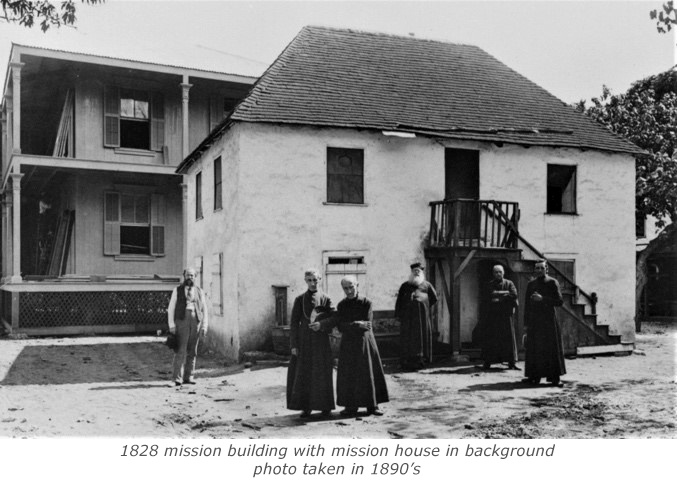 Philippe de Morineau, leader of the French community in Honolulu, secured a grant of land for the mission from King Kamehameha III. Located at the site of the present Cathedral of Our Lady of Peace, it was to become the center of the Honolulu Catholic Mission. The mission house served as the residence for Honolulu priests who ministered at several chapels and quasi parishes until the early 20th century. Two of the first Honolulu parishes to have their own resident priests in the 1920’s were St. Augustine in Waikiki and Sacred Heart on Wilder Avenue.
Philippe de Morineau, leader of the French community in Honolulu, secured a grant of land for the mission from King Kamehameha III. Located at the site of the present Cathedral of Our Lady of Peace, it was to become the center of the Honolulu Catholic Mission. The mission house served as the residence for Honolulu priests who ministered at several chapels and quasi parishes until the early 20th century. Two of the first Honolulu parishes to have their own resident priests in the 1920’s were St. Augustine in Waikiki and Sacred Heart on Wilder Avenue.
The missionaries, however, were not given a warm reception in the Hawaiian Kingdom. Seven years earlier, the members of the American Protestant Mission of Massachusetts arrived. They had established themselves and gained favor with the Hawaiian royalty. However, for a while our brothers had the protection of Boki, the Royal Governor of O’ahu. With some foresight they began preparing lay catechists who were instrumental in the growth of the faith in the mission.
In late 1829 Governor Boki departed on an expedition. Persecution of Catholics began, led by Queen Kaahumanu. Boki never returned, his ship was lost at sea. By the end of 1831, Fr. Armand and Brs. Boissier and Portal had returned to France. The Queen expelled Fathers Bachelot and Short on December 24, 1831 and left for California. Br. Bondu was left alone to hold the fledgling mission together. Brother Portal returned to Hawai’i in 1834.
In September 1836 Father Robert Arsenius Walsh, ss.cc. arrived in Hawaii. As a British citizen, he was allowed to stay but was banned from public preaching. Thinking that things were improving Fathers Bachelot and Short returned in April 1837. A few months later Father Louis Maigret, ss.cc. arrived from France. The priests were again ordered to leave. In October, Fr. Short left the islands. In November, Frs. Bachelot and Maigret departed for Ponape. In December 1837 the Catholic religion was declared illegal by official ordinance. During this period, the natives were given harsh punishments for the "crime" of being Catholic. Hundreds were imprisoned and forced into hard labor. It took a threat of war to stop the persecution. On July 9, 1839, the French warship L'Artemise arrived in Honolulu Harbor. Captain Laplace demanded religious freedom for Catholics in Hawaii. King Kamehameha III, fearing an attack, issued the Edict of Toleration, giving Catholics the freedom to worship.
In 1833, Rome had created the new Vicariate Apostolic of Eastern Oceania, headquartered in Valparaiso, Chile. The Hawaiian mission was placed under this new Vicariate. Fr. Etienne Rouchouze, ss.cc. was named Vicar Apostolic and Titular Bishop of Nilopolis. With religious liberty assured in Hawaii, Bishop Rouchouze visited in 1840 accompanied by Fr. Maigret, who had been in Mangareva, and Frs. Ernest Heurtel, ss.cc. and Dosithé Desvault, ss.cc. who were in the Marquesas.
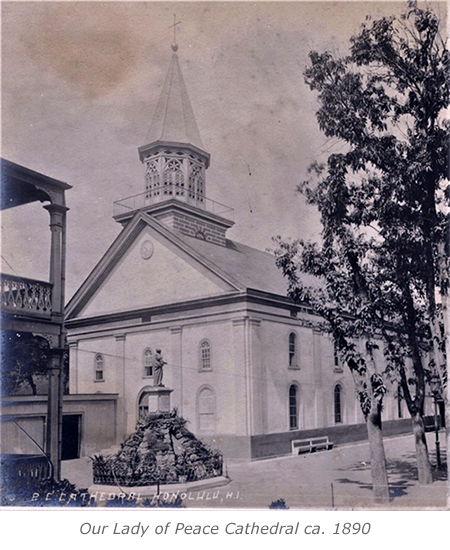 Under the new mantle of religious liberty, the Catholic mission could grow and expand. Seeing the mission chapel had become too small to accommodate the growing community of faith, Bishop Rouchouze laid the cornerstone for the Cathedral of Our Lady of Peace on August 6, 1840. It was dedicated on August 15, 1843.
Under the new mantle of religious liberty, the Catholic mission could grow and expand. Seeing the mission chapel had become too small to accommodate the growing community of faith, Bishop Rouchouze laid the cornerstone for the Cathedral of Our Lady of Peace on August 6, 1840. It was dedicated on August 15, 1843.
In 1841 O’ahu was divided into mission districts. and Fr. Martial Jan, ss.cc. was assigned to the Ko’olau district. Working from He’eia many chapels were establish in windward O’ahu. Education was thought to be key to spreading the Catholic Faith. With the spread of the mission, mission schools were established. In 1846 Ahuimanu College was opened on the windward side. It would evolve and move, eventually becoming the modern-day St. Louis High School in Kaimuk?.
Very soon the missionary endeavors spread to the neighboring islands. Fr. Walsh was particularly instrumental in this evangelization. He and Fr. Heurtel landed in Kailua-Kona on the Island of Hawai’i in June 1840. Walsh’s next mission was Kaua’i. He celebrated mass at Koloa on Christmas day 1841. Then he spent three weeks on Ni’ihau in 1842. The mission on Maui began in 1846. When the missionaries landed in Lahaina, they found 4,000 catechumens prepared by the renowned lay catechist Helio Koaeloa.
Realizing the prospects for expanding the mission, in 1841 Bishop Rouchouze sailed to France to recruit more missionaries and raise monies. He was successful in his endeavor. He acquired a ship for his return, named the Marie-Joseph in honor of the Founder. The Marie-Joseph left St. Malo on December 15, 1842. Aboard ship was the bishop, six priests, a subdeacon, seven lay brothers, and ten sisters. Tragedy struck! After a stop in Florianopolis, Brazil the ship set sail February 1843 and was never seen again.
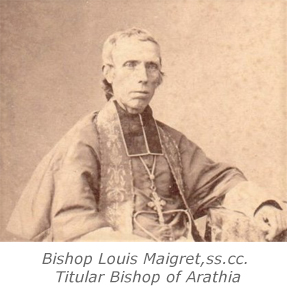 After the disappearance of Bishop Rouchouze, the three prefectures of the Vicariate Apostolic of eastern Oceania were elevated into independent vicariates apostolic. In 1847 Pope Pius IX created the Vicariate Apostolic of the Sandwich Islands and Fr. Maigret was appointed Vicar Apostolic and Titular Bishop of Arathia. He was consecrated in Valparaiso, Chile. In 1848 the name was changed to Vicariate Apostolic of the Hawaiian Islands. The mission continued to grow and flourish. It was at Bishop Maigret’s request for volunteers, in 1873, that St. Damien was the first to volunteer to serve in Kalaupapa.
After the disappearance of Bishop Rouchouze, the three prefectures of the Vicariate Apostolic of eastern Oceania were elevated into independent vicariates apostolic. In 1847 Pope Pius IX created the Vicariate Apostolic of the Sandwich Islands and Fr. Maigret was appointed Vicar Apostolic and Titular Bishop of Arathia. He was consecrated in Valparaiso, Chile. In 1848 the name was changed to Vicariate Apostolic of the Hawaiian Islands. The mission continued to grow and flourish. It was at Bishop Maigret’s request for volunteers, in 1873, that St. Damien was the first to volunteer to serve in Kalaupapa.
Bishop Maigret, ss.cc. died in 1882. From 1882 to 1940 the Vicariate Apostolic of the Hawaiian Islands was served by four other Sacred Hearts Vicars Apostolic: Herman Koeckemann, ss.cc, Titular Bishop of Olba (1882–1892), Gulstan Ropert, ss.cc, Titular Bishop of Panopolis (1892–1903), Libert H. Boeynaems, ss.cc, Titular Bishop of Zeugma in Syria (1903–1926), Stephen Alencastre, ss.cc, Titular Bishop of Arabissus (1926–1940).
Bishop Alencastre died aboard a ship on route from Los Angeles on November 9, 1940. With Bishop Alencastre’s death the mission status of the Catholic Church in Hawai’i ended. Pope Pius XII erected the new Diocese of Honolulu on January 25, 1941.
THE HAWAIIAN PROVINCE
The acceptance of the foreign missions brought with it the establishment of religious houses of members of the Congregation in the Vicariate Apostolic. In May 1838, the General Council “considering that the brother employed in said missions must never be without a Superior to whom them might have recourse” provisionally decided that the Superior General would appoint a Brother as Superior, until the General chapter could take up the matter. They gave the appointed Superior the title of Provincial of the Missions in Oceania. In addressing this need the General Chapter of 1838 added several articles to the new Constitutions which Rome approved in 1840. Article 396 of the 1840 Constitutions defines the position. “...among the missionaries a priest will be designated who under the title of Provincial will be superior of all the members of the Congregation employed in this mission and to whom all will have resource for what concerns their duties as religious.”
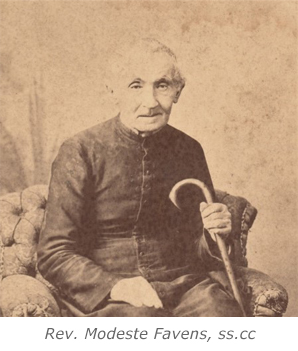 In 1838 the Mission Province of America and Oceania was erected. The Superior General appointed Fr. François Caret, ss.cc. as Provincial. He became Vicar Apostolic of Southern Oceania in 1840. In 1845 Fr. Dosithé Desvault, ss.cc. succeeded him as Provincial.
In 1838 the Mission Province of America and Oceania was erected. The Superior General appointed Fr. François Caret, ss.cc. as Provincial. He became Vicar Apostolic of Southern Oceania in 1840. In 1845 Fr. Dosithé Desvault, ss.cc. succeeded him as Provincial.
In 1868 Hawai’i became an independent mission Province, with Fr. Modeste Favens, ss.cc. as the first Provincial Superior. In 1946 it became an ordinary province under the title Province of Hawai’i. On November 13, 2011 the Province of Hawai’i merged with the United States East Province to become the Province of the United States of America.
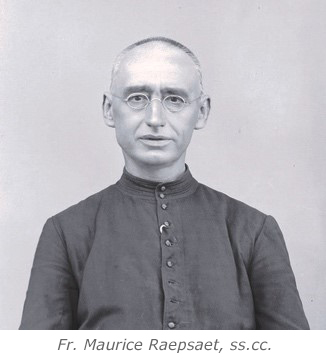 THE FALL RIVER MISSION
THE FALL RIVER MISSION
In March 1904, a new diocese was created in U.S. Catholic Church, with its seat in Fall River, Massachusetts. Fr. William Stang was appointed its first bishop. Prior to his appointment Fr. Stang, had taught at the American College in Louvain, Belgium, where he became acquainted with Fr. Maurice Raepsaet, ss.cc., provincial of the Belgian Province of the Congregation of the Sacred Hearts of Jesus and Mary.
Bishop Stang invited Fr. Raepsaet to send members of the Congregation to minister in the new Fall River Diocese. Fr. Raepsaet agreed. In 1905, five members of the Congregation set sail for the U.S. Brothers Hubert Rakel, ss.cc. and Jean Baptiste Leygraef, ss.cc. along with Fathers Stanislaus Bernard, ss.cc, Hilarion Eikerling, ss.cc, and Bernard Pierson, ss.cc. arrived in Boston in May 1905. The Community moved into building now known as Damien Residence in Fairhaven.
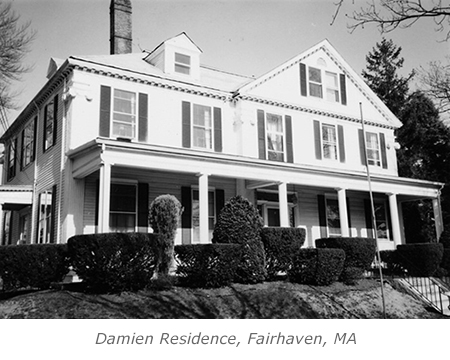 Some excerpts from the letters between Bishop Stang and Fr. Raepsaet specify what was in the agreement signed by them on October 20, 1905:
Some excerpts from the letters between Bishop Stang and Fr. Raepsaet specify what was in the agreement signed by them on October 20, 1905:
"Therefore, it is expressly agreed that the Fathers will establish with the goodwill of the Bishop a religious community in Fairhaven, near New Bedford with a view to a) spreading devotion to the Sacred Hearts and to the Most Blessed Sacrament of the Altar in conformity with the purpose and goal of their institute, and b) occupy themselves with the ministry of the new parish of Fairhaven, to give their service to the Germans of New Bedford on to exercise the apostolate among the population of Cape Cod.”
Two days after their arrival, May 21, the Fathers presided at the first parochial Mass for the Catholics of Fairhaven. They established two parishes, Saint Joseph in Fairhaven, for French and Portuguese Catholics, and Our Lady of the Assumption in New Bedford, for those from the Cape Verde Islands. Within a year, Father Eikerling had also established Saint Boniface, for German Catholics, in New Bedford. In 1908, the cornerstone for a new church, Sacred Hearts Church, was laid.
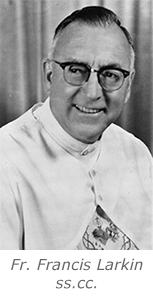 St, Francis Xavier (Acushnet), Holy Trinity (West Harwich), and Our Lady of Lourdes (Wellfleet) communities were entrusted to the Congregation of the Sacred Hearts in 1910.The first five years following the arrival of the Congregation saw a rapid expansion of the apostolate in the Fairhaven, New Bedford, Acushnet, and Cape Code areas.
St, Francis Xavier (Acushnet), Holy Trinity (West Harwich), and Our Lady of Lourdes (Wellfleet) communities were entrusted to the Congregation of the Sacred Hearts in 1910.The first five years following the arrival of the Congregation saw a rapid expansion of the apostolate in the Fairhaven, New Bedford, Acushnet, and Cape Code areas.
The early community was quick in spreading devotion to the Sacred Hearts. The Exterior Association of the Sacred Hearts was founded early. The Academy of the Sacred Hearts Sisters in North Fairhaven became the National Center of the Enthronement in the United States. 1943, Fr. Francis Larkin, ss.cc. was appointed National Director, and the National Center moved to Sacred Hearts Seminary in Washington, DC. In 1949, the Center published the first Enthronement magazine in the United States, entitled Social Reign The agreement signed between Bishop Stang and the provincial, Fr. Raepsaet, specified that, "outside of the sacred ministries, which are confided to the Fathers in the diocese, the Fathers are authorized to establish a college for education." A building to serve as the administration building for the college was constructed in 1907, which is the present house at 77 Adams in Fairhaven. Classes were begun for a small number of students in the administration building in 1910. The project never progressed and was terminated by the Congregation.
There was some expansion outside of the Fall River diocese after the closing of the college. Fr. Van der Muelen, ss.cc. worked with the French and Belgian populations in the Church of Our Lady of Victory in downtown Rochester, New York, entrusted to the Congregation in 1928.
In 1928 the mission began formation for prospective candidates, opening a novitiate at 77 Adams Street in Fairhaven in 1928. After novitiate, the newly professed religious went to Belgium for philosophical and theological studies until the opening of the seminary in Washington D.C. in 1935. In September of 1954, the faculty and students moved to Queen of Peace Seminary in Jaffrey, New Hampshire. It served as a minor seminary and then became the major seminary for the province until 1969. In that year the Congregation, with five other religious communities, became a founding member of the Coalition of Religious Seminaries, that became the Washington Theological Union, in Washington, DC.
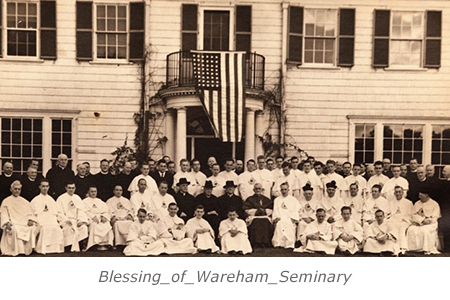 In 1944, the building on Adams Street, became a preparatory seminary for the new province. The community had purchased a large property in Wareham, MA in 1942. The preparatory seminary was moved there in 1948. Later a new college seminary, Fr. Damien Seminary, was built on the campus of St. Mary's college in Winona, Minnesota. In the 1960s and 1970s. Sacred Hearts Seminary in Wareham went through many changes from its acquisition in 1942 until its sale in 2019. It served as a house of philosophy, a minor seminary, and a novitiate. Most recently it was Sacred Hearts Seminary Retreat House.
In 1944, the building on Adams Street, became a preparatory seminary for the new province. The community had purchased a large property in Wareham, MA in 1942. The preparatory seminary was moved there in 1948. Later a new college seminary, Fr. Damien Seminary, was built on the campus of St. Mary's college in Winona, Minnesota. In the 1960s and 1970s. Sacred Hearts Seminary in Wareham went through many changes from its acquisition in 1942 until its sale in 2019. It served as a house of philosophy, a minor seminary, and a novitiate. Most recently it was Sacred Hearts Seminary Retreat House.
THE PROVINCE OF THE UNITED STATES EAST
During the early years in the United States, the development of community life in the Congregation was under the direction of local superiors responsible to the provincial of the Belgian Province. It provided the necessary personnel and financial resources for the community to accomplish its mission. In 1939, the mission was given a greater degree of autonomy becoming a pro-province of the Belgian Province. Fr. Columban Moran, ss.cc. appointed as provincial to the pro-province. In 1947 the Province of the United States was erected with Fr. Moran as Provincial.
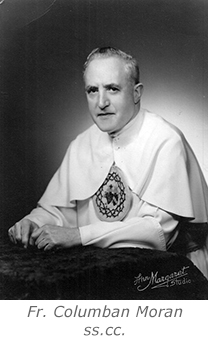 The new Province had a rapid expansion. In 1948, a largely unevangelized area of Japan, lbaraki Prefecture, was accepted as a mission by the new province. In June of the following year, three priests were assigned to lbaraki. Ten years later, the province accepted an additional prefecture in Japan, Yamagata Prefecture in northern Honshu. Also, 1948 a house was opened in Ireland and within a short number of years minor and major seminaries were established there. The same year a rural parish, St. Matthew's, was entrusted to the Congregation in Mount Gilead, Ohio.
The new Province had a rapid expansion. In 1948, a largely unevangelized area of Japan, lbaraki Prefecture, was accepted as a mission by the new province. In June of the following year, three priests were assigned to lbaraki. Ten years later, the province accepted an additional prefecture in Japan, Yamagata Prefecture in northern Honshu. Also, 1948 a house was opened in Ireland and within a short number of years minor and major seminaries were established there. The same year a rural parish, St. Matthew's, was entrusted to the Congregation in Mount Gilead, Ohio.
The Province was invited into the Diocese of Los Angeles in California in 1954 and entrusted with the parish of our Lady of Guadalupe in Laverne and the mission in San Dimas. Later, the chaplaincy of Pomona State Hospital was accepted and teaching apostolates at Bishop Amat, Bishop Allemany, and Pomona Catholic High School (now Damien High School). The mission was accepted in the new Diocese of Nassau in the Bahamas in 1961 in Abaco. The mission spread to New Providence, Bimini, Eleuthera, Harbour Island and Long Island. The Province left the Bahamas in the early 2000’s. In 1967 the invitation of Bishop of Brownsville, Texas to work in the Rio Grande valley was accepted. We still serve Queen of Peace and Immaculate Heart of Mary in Harligen.
In 1975, the mission in India began with the arrival of Fr. Bill Petrie. Under the sponsorship of the now St. Teresa of Kolkata ministry began in Leprosy Centers and work in vocations and formation. Damien Social Development Institute was founded and recently parish ministries have begun.
After much growth and expansion, the United States Province’s missions began to take on their own autonomy in the 1960’s. In 1963 the US-West became a pro-province and a vice-province in 1966. The same year Ireland-England became a pro-Province and Japan a Vice-Province. In 1970 the United State Province was split into the United States East Province, and the Quasi Provinces of United States West and Ireland-England.
In 1982 the United States West became a regular province and Ireland-England followed in 1983. In 2007 India became a region of the US East Province. In 2009 the Vice-Province of Japan was combined with the Philippines to form the Province of Japan-Philippines. Then on November 13, 2011 the US East and Hawai’i Provinces merged to become the Province of the United States of America. India remains a region of the new Province. In 2013 the US West, now a delegation, became a region of the USA Province.